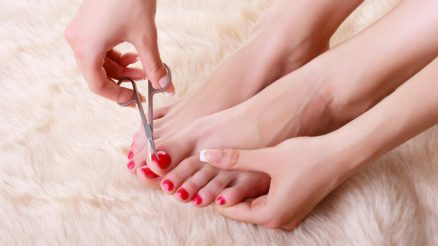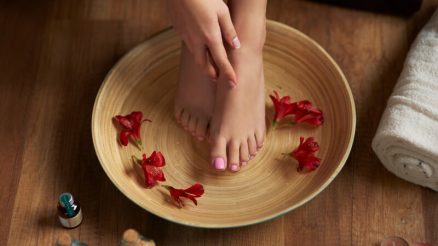Our toenails are often overlooked, yet they play an important role in protecting our toes and supporting overall foot health. Neglecting toenail care can lead to problems such as fungal infections, ingrown nails, discoloration, and discomfort. With a few simple habits, however, you can maintain strong, healthy toenails that not only look good but also feel great. In this guide, we’ll explore practical and effective tips for keeping your toenails in top condition.
10 Proven Tips for Healthy Toenails
1. Practice Good Foot Hygiene
Keeping your feet clean and dry is the foundation of toenail health.
- Wash your feet daily with mild soap and warm water. This helps remove dirt, sweat, and bacteria that can contribute to infections.
- Dry thoroughly, especially between the toes, to prevent fungal growth. Moisture trapped between the toes creates a breeding ground for fungi.
- Use a foot powder if you’re prone to sweaty feet. Antifungal powders can help keep your feet dry and prevent athlete’s foot and toenail fungus.
- Change socks daily and more frequently if your feet sweat a lot.
- Disinfect your shoes occasionally to reduce bacterial and fungal buildup.
2. Trim Toenails Correctly
Improper trimming can cause painful ingrown toenails or splits.
- Use clean, sharp nail clippers designed for toenails to avoid jagged cuts and accidental tears.
- Cut nails straight across rather than rounding the edges to prevent them from growing into the surrounding skin.
- Don’t cut them too short—leave a small margin beyond the nail bed to protect the toe.
- File the edges gently to smooth rough spots and prevent snagging on socks or shoes.
3. Wear Proper Footwear
Tight or poorly fitting shoes can damage toenails and encourage fungal infections.
- Choose shoes with a wide toe box to reduce pressure on the nails and allow toes to move freely.
- Wear breathable socks and shoes to allow airflow and reduce sweat buildup.
- Avoid high heels or pointed shoes that crowd the toes and increase the risk of trauma.
- Rotate shoes regularly to allow them to dry out between uses.
4. Moisturize Your Feet and Nails
Nails need hydration just like skin.
- Apply moisturizing lotion or cream to your feet, including your nails and cuticles, to prevent cracking and dryness.
- Use cuticle oil or vitamin E oil to nourish the nail bed and promote healthy growth.
- Avoid excessive soaking in hot water, which can strip natural oils and cause nails to become brittle.
5. Protect Your Feet in Public Areas
Fungal infections thrive in moist environments such as locker rooms and public showers.
- Always wear flip-flops or shower shoes in communal areas like gyms, pools, and dorm bathrooms.
- Dry your feet thoroughly after exposure to these environments.
- Disinfect flip-flops or sandals regularly to prevent contamination.
6. Avoid Nail Trauma
Injuries to the toenail can lead to thickened nails, discoloration, or even nail loss.
- Be cautious when trimming nails or performing foot care; never rush the process.
- Protect your feet during sports or heavy activities with appropriate footwear, such as steel-toe boots or athletic shoes.
- Don’t use toenails as tools to pick or pry things—this can cause cracks or detachment.
- If you stub your toe or drop something heavy on it, monitor the nail for damage and seek care if discoloration or pain persists.
7. Give Your Nails a Break from Polish
While nail polish can look great, frequent use can weaken nails and cause discoloration.
- Go polish-free for a few days each month to allow your nails to breathe and recover.
- Use non-toxic, breathable nail polishes when painting your toenails to minimize chemical exposure.
- Always apply a base coat to protect the nail surface from stains and damage.
- Avoid harsh acetone-based removers which can dry out the nail plate.
8. Eat a Nail-Healthy Diet
Your toenail health is influenced by your overall nutrition.
- Eat foods rich in biotin, zinc, iron, and protein, which support nail strength and growth.
- Include leafy greens, eggs, nuts, fish, and whole grains in your meals to provide essential nutrients.
- Stay well-hydrated to keep nails flexible and resistant to cracking.
- Consider a multivitamin or supplement if your diet lacks key nutrients—consult your healthcare provider first.
9. Watch for Signs of Nail Problems
Early detection of nail issues can prevent complications.
- Look out for discoloration, thickening, pain, or changes in shape, which may signal underlying health issues.
- Don’t ignore foul odors or crumbling nails—these may indicate a fungal infection that requires treatment.
- If you suspect a problem, see a podiatrist or dermatologist for proper evaluation and treatment.
- Keep track of recurring issues to help identify triggers or habits contributing to nail problems.
10. Regularly Inspect and Care for Your Toenails
Preventive care is the key to long-term toenail health.
- Make toenail care a part of your weekly grooming routine to spot issues early and maintain cleanliness.
- Consider professional pedicures occasionally, ensuring tools are properly sanitized and technicians are trained.
- Treat your feet with the same care you give your hands—regular maintenance improves both appearance and health.
- Store toenail care tools in a clean, dry place and disinfect them after each use.
Final Thoughts
Healthy toenails are a sign of good hygiene and overall well-being. By incorporating these simple tips into your routine, you can avoid many common foot issues and enjoy strong, attractive toenails year-round. Remember, caring for your feet isn’t just about aesthetics—it’s about health, comfort, and confidence with every step you take.








